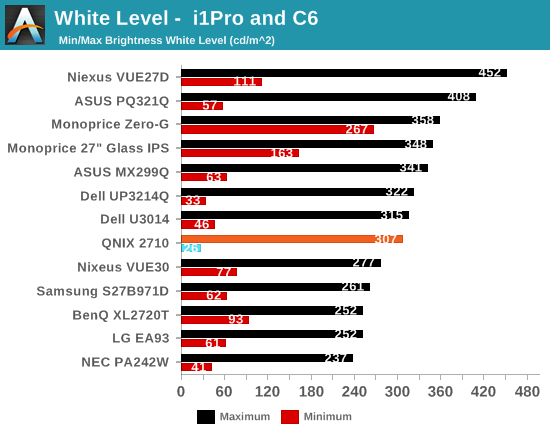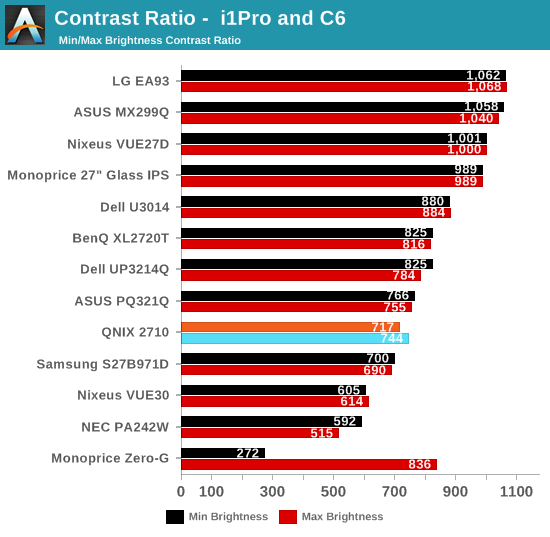QNIX QX2710 LED DPmulti True10 Review
by Chris Heinonen on April 11, 2014 6:00 AM ESTBrightness and Contrast
As I mentioned, I am not using the dynamic contrast feature for any of these measurements. Since it does not allow you to adjust the brightness when it is enabled, it will be far too bright for regular use and seems designed to mostly produce a number that looks good on spec sheets. In use it also takes nearly 3 seconds to respond to a change in average picture level, which most people will find too slow and annoying in actual use.
When the backlight is set to the maximum, a white field puts out 307 cd/m2 of light. Setting the backlight to minimum causes the white reading to fall down to 26 cd/m2. While the backlight setting is adjustable from 0-100, it is only adjustable in increments of 3, so it is really 0-33. These coarse adjustments cause issues later on as hitting 200 cd/m2 is a bit harder.

The black level with the backlight at maximum is a rather high 0.4122 cd/m2 and with it at minimum it is 0.0369 cd/m2. While the AUO panel used is AHVA, this is really more of an IPS type panel as opposed to being a VA type panel. AHVA (Advanced Hyper-Viewing Angle) is fundamentally different than VA (Vertical Alignment), and PVA/MVA panels would generally show much better black levels than this.

These combine to have mediocre contrast ratios of 717:1 and 744:1. Modern IPS panels are now doing over 1,000:1 and VA panels can be past 4,000:1. Since this is the first AHVA panel I’ve seen I’m not sure if this is an overall flaw with the AHVA technology or with the implementation in this monitor -- or perhaps a bit of both.

The QNIX is plenty bright and offers a nice lower level brightness setting as well. The rest of the brightness settings are too coarse to easily select a specific level, while the black level and contrast ratios suffer overall. In short, this isn't a professional grade display, but then the pricing and source should have already made that abundantly clear.










85 Comments
View All Comments
KVFinn - Friday, April 18, 2014 - link
>First of all - these aren't the monitors people want from Korea, the ones you buy are the QNix QX2710 and the X-Star DP2710 (or the Catleaps if you want to go back in time to when this started).Yup. This is not the 'QNIX' people are talking about when they talk about the great value in Korean monitors. Anyone following the recommendations knows to stay away from this model.
As it stands, the only way to get a 1400p IPS/PLS display at greater than 90 (and sometimes all the way to 120) is STILL the Korean QX2710 or DP2710 which are both still shipping for less than 300 dollars. It's not just a bargain it's literally the only way to find a display that meets those requirements.
blackoctagon - Thursday, May 1, 2014 - link
To make matters even more confusing, the QNIX QX2710 exists in both multi-input and DL-DVI-only variants. Only the latter variant OC's properly without skipping framesyasamoka - Friday, April 11, 2014 - link
Appreciate the review, but this model has been known since shortly after release in the OCN Qnix / X-Star PLS club to be the worst of the Qnix family, best avoided.The monitor has high input lag (2 frames), low contrast ratio (700:1), doesn't overclock (skips frames), and uses PWM backlight control. I knew these even before I read your review. Your review confirms that this is a Korean monitor best avoided.
On the other hand, the Qnix QX2710 Evolution II single-input and multi-input models have none of these issues. The single-input DVI dual-link model has no input lag (~2-3ms?), higher contrast ratio (900:1 - 1100:1), overclocks to 100Hz+ easily (many get 110-120Hz), and very very few users have ever reported PWM flicker, meaning most likely it either doesn't use PWM at all (save for 2-3 cases on the Internet ~160Hz) or it uses a high frequency not visible to most / all (mine).
The multi-input model has 1 frame of lag, not 2, doesn't OC, and one measurement put it at 900:1 (NCX - had another 1100:1 single-input glow-free PWM-free Matte).
NCX's review:
http://wecravegamestoo.com/forums/monitor-reviews-...
These are my results with my Qnix QX2710 EvoII single-input DVI-DL (out-of-the-box; arrived August 1, 2013; measured recently late March,2014) - using an i1 Display Pro, HCFR for measurements, ArgyllCMS + dispcalGUI for calibration and profiling:
Grayscale accuracy: http://i.imgur.com/QCDtnqD.png
RGB Levels: http://i.imgur.com/9rsH7DK.png
Color temperature: http://i.imgur.com/1rjeumA.png
Gamut: http://i.imgur.com/EhDD1EK.png
Gamma @ 2.04, Contrast Ratio @ 890:1, average DE @ 1.9
My monitor is one of those with a slight yellowish tint out-of-the-box. Imagine how the samples that don't have this tint would measure (NCX - ~perfect white, little difference with calibration).
Calibration & Profiling results:
Profiling results (ArgyllCMS + dispcalGUI): http://i.imgur.com/tkFrJ7n.png
This shows a 99.7% sRGB gamut coverage and a 75.1% Adobe RGB gamut coverage.
Grayscale accuracy: http://i.imgur.com/v4acVp3.png
RGB Levels: http://i.imgur.com/WWJ8GwV.png
Color temperature: http://i.imgur.com/zfNgbiN.png
Gamma @ 2.21, Contrast Ratio @ 856:1, average DE @ 0.27
Uniformity?
https://www.dropbox.com/s/g6rldfq2fru316r/Qnix%20Q...
-06.62% -00.88% -00.79% -04.79% -13.17%
-14.44% -03.14% -02.92% -12.66%
-11.33% -11.10% -05.40% -04.72% -03.80%
This is with my monitor having slight yellow bleed (because of the case causing pressure) starting from the bottom middle stretching towards the right side of the screen, visible only in the darkest of scenes with the lights off.
Overclocks to 110Hz with some tightened timings, reaches 116Hz or so before it starts artifacting lightly (120Hz has ~2 green lines constantly on the screen). All on the stock cable and same GPU DVI-DL port.
itpromike - Friday, April 11, 2014 - link
So if someone were looking at a $500 or less monitor with the best quality that price could afford which would be advised? Would it be one of the Korean models you just mentioned or is their a normal reputable vendor like Asus or ViewSonic that have a good quality monitor around this price? I'm looking for something as close to the quality of the Apple Thunderbolt quality/panel as possible.iamkyle - Thursday, April 17, 2014 - link
I personally acquired an X-Star DP2710 LED (identical to the QX2710 that yasamoka has). I would say the ONLY drawbacks are the el-cheapo stand, and only a DL-DVI input.But really? Compares to the positives? My monitor has NO dead pixels, overclocks to 120Hz with no dropped frames or random anomalies, and has 1000:1 contrast ratio. Do you really need 2 inputs? No son, you need 2 monitors!
I paid $300USD + $50 in taxes and import fees on delivery = $350.
Do not let Anandtech's review sway you as they reviewed a totally different monitor. For the resolution, colour quality, and price it's easily the best thing under $500.
vasiln - Wednesday, April 23, 2014 - link
I created an account to reply to this. I just purchased a single-input QX27 Evo II via an Amazon reseller. (Had a small defect in corner of screen, so in transit for replacement; whole process was very smooth, reseller very cooperative, in case this is a cause of worry for anyone.)The image quality is imperfect. There is some light bleed (this is common, but varies from monitor to monitor) which leads to problems with brightness uniformity. Contrast is good, but I still have to settle for some crushed whites or some crushed blacks. Overall, however, the image quality makes me very happy. It is miles ahead of my old TN screen. Just, it's not appropriate for graphics professionals.
As far as gaming, my monitor overclocked to 120hz without graphical glitches. Again, this varies, but 96hz seems like a very reasonable and easily achieved overclock. Verified via testUFO, btw. Reports are of 1ms input lag, which I find hard to believe, but I will say that I (no professional gamer) noticed no input lag. However, 120hz on a monitor like this isn't 120hz on a benq or asus with a strobe, because of persistence. Much as with image quality, gaming performance is very good, but not appropriate for a gaming professional.
And the price is right. Amazon resellers have these available for $350. These resellers aim to please, because they're getting good money, but have to keep Amazon happy to stay listed, and Amazon is happy if you're happy.
So it's not a great monitor towards any particular purpose, and it's not a great monitor at any price point, but for its cost, I am really happy with the QNIX, and think it's a wonderful jack-of-all-trades.
StevenBMay - Friday, April 11, 2014 - link
The confusion has come in when people have begin referring to 1920x1080 as "HD". By that definition, "QuadHD" then implies 4x1080p or 4K, which is incorrect. QuadHD has always been 2560x1440. So the confusion doesn't come from how the article is written - it comes from the incorrect definition of "HD" that has perpetuated over the last few years as new confusing acronyms are coined for higher-resolution displays. http://s6x.it/l521Conficio - Friday, April 11, 2014 - link
More than $100 difference between this QNIX and the Monoprice. Matte vs Glossy as far as I can see in the pictures.okashira - Friday, April 11, 2014 - link
It is unfortunate that anandtech chose to review one of the worst of the Qnix / X-Star Korean monitors.The QX2710 or the DP2710LED are far superior.
kmmatney - Friday, April 11, 2014 - link
I still appreciate the review. Between the review and the comments I have a much better understanding of these low cost monitors. I'm still rocking a 24 inch Soyo Topaz, which I love, but will be looking at these when mine dies.